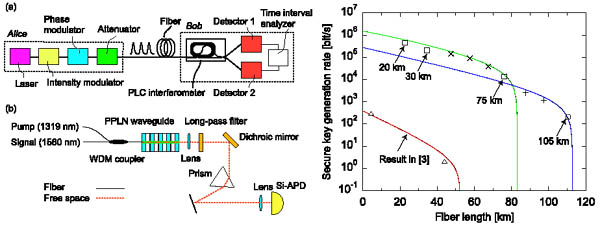Hiroki Takesue1, Toshimori Honjo1 and Kyo Inoue2
1Optical Science Laboratory, 2Osaka University/NTT Research Professor
The differential phase shift quantum key distribution (DPS-QKD) protocol has been attracting attention in recent years because of its robustness against strong attacks including a photon number splitting attack [1]. Here we report a fast and long-distance DPS-QKD experiment using single photon counters based on frequency up-conversion in periodically poled lithium niobate (PPLN) waveguides [2].
Fig. 1 (a) shows the experimental setup. A continuous lightwave from
a laser is modulated into pulses with a width of 100 ps and a 1-GHz repetition
frequency using an intensity modulator. Each pulse is randomly phase-modulated
by {0,π} with a phase modulator, and attenuated by an optical attenuator
to give an average photon number per pulse of around 0.2. The pulse train
is then transmitted over fiber spools and input into a 1-bit delayed Mach-Zehnder
interferometer based on planar lightwave circuit technology, whose two
output ports are connected to up-conversion detectors. The configuration
of the up-conversion detector is shown in Fig. 1 (b). A 1.5-µm photon
is combined with a 1.3-µm pump lightwave and then input into a PPLN
waveguide, where the 1.5-µm photon is converted into a 0.7-µm
photon. The converted photon are transmitted through an optical filter
system to suppress noise photons, and received by a silicon avalanche photodiode
(Si-APD). Since an Si-APD can be operated in a non-gated mode, we can significantly
increase the key generation rate by employing the up-conversion detectors
in a fast clock QKD system.
We first set the quantum efficiency (QE) and the combined dark count rate (DC) at 9% and 26 kHz, respectively. The obtained secure key rates as function of fiber length are shown by squares in Fig. 2. We have generated secure keys at a rate of 455 kbit/s over 20 km of fiber, and also achieved 1-Mbit/s sifted key rate over 30 km of fiber. We then reduced the QE and DC to 2% and 2.7 kHz, respectively, to improve signal to noise ratio. As a result, we have successfully generated secure keys at a rate of 209 bit/s over 105 km fiber (the circle). The triangles show the secure key rate of a BB84 QKD system reported in [3]. Thus, we have significantly increased both secure key rate and distribution distance.
This result is an important step toward realization of long-distance QKD systems.
[1] K. Inoue et al., Phys. Rev. Lett. 89 (2002) 037902.
[2] H. Takesue et al., New J. Phys. 7 (2005) 232.
[3] C. Gobby et al., Electron Lett. 40 (2004) 25.
 |
|
| Fig. 1. Experimental setup. | Fig.2. Secure key rate. |